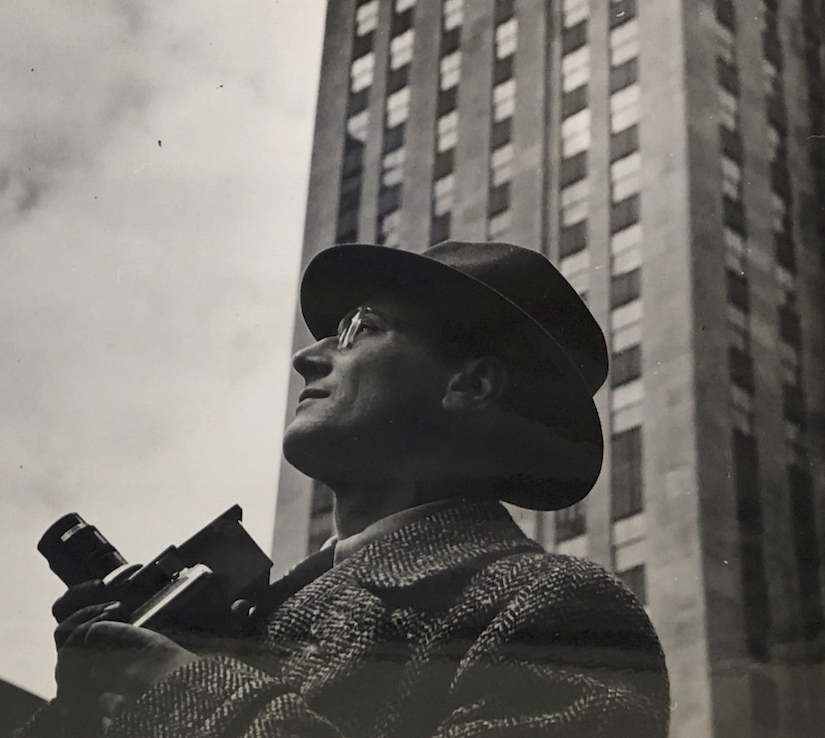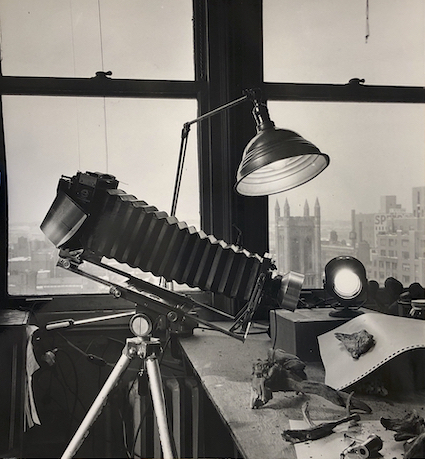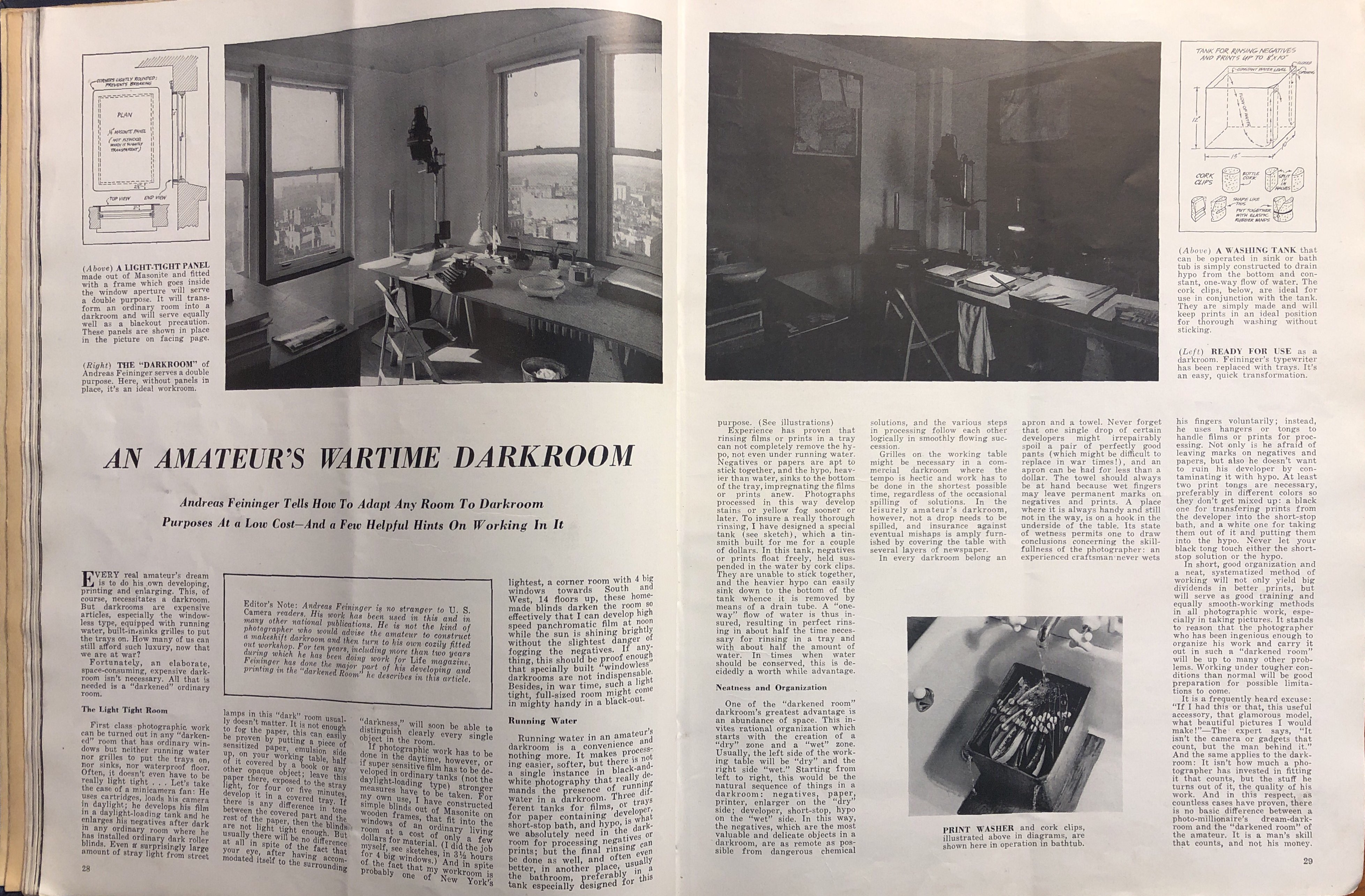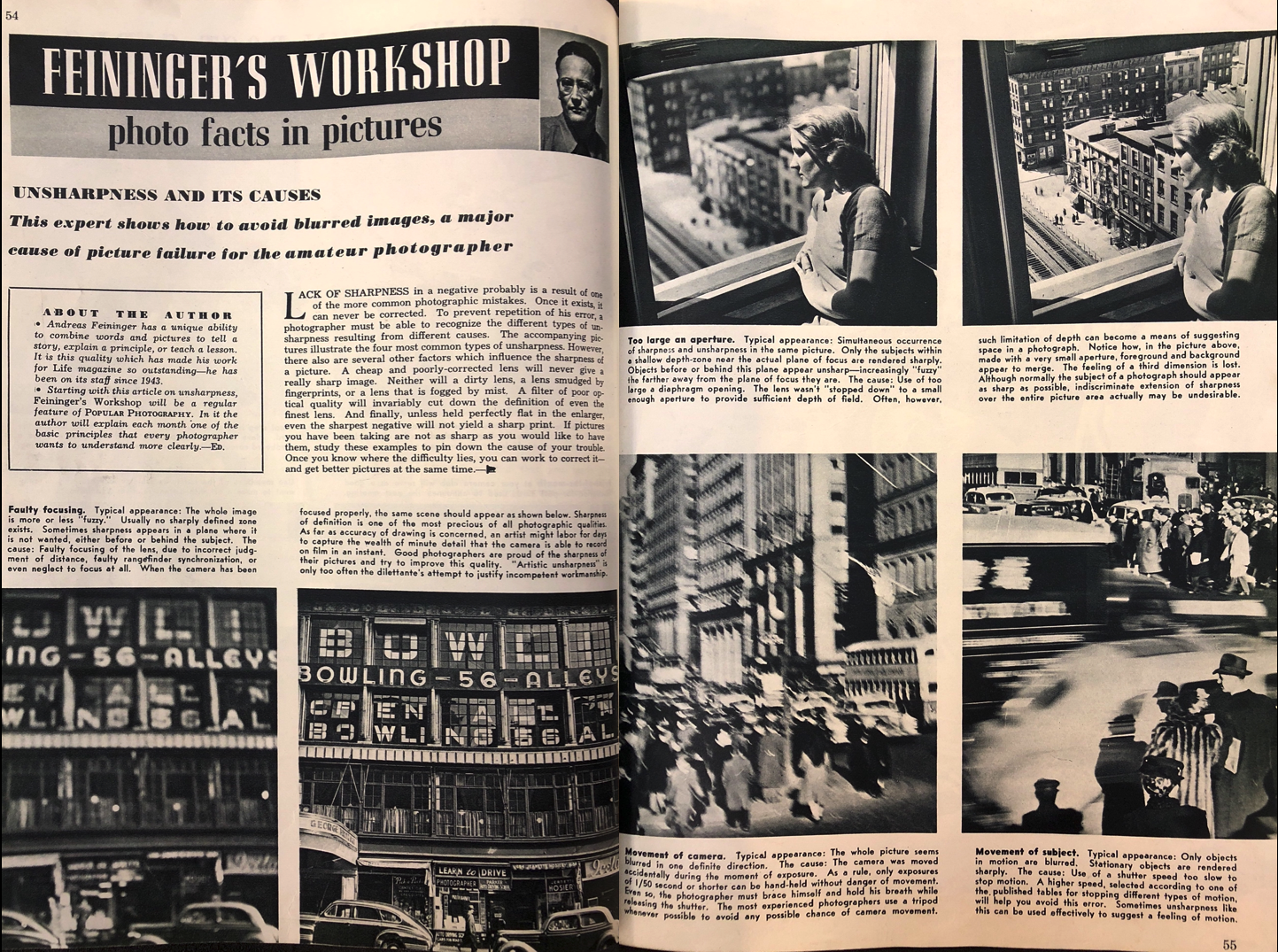Archive
Andreas Feininger
- Andreas
- Feininger
- 27-12-1906
- Paris (FR)
- 18-02-1999
- New York City (US)
- PhotographerWriterEditor
Andreas Feininger, was a German émigré photographer who arrived in New York with his wife Wysse Feininger in 1939. He started a lifelong career exploring the city's streets, working as a photojournalist and writing a large number of photography manuals.
Word Count: 39

Portrait of Andreas Feininger by Fritz Henle, 1940/41, cropped detail (© Center for Creative Photography, University of Arizona: Andreas Feininger Archive, Photo: Helene Roth). 
Portrait of Andreas Feininger by Fritz Henle, 1940/41 (© Center for Creative Photography, University of Arizona: Andreas Feininger Archive, Photo: Helene Roth). 
Andreas Feininger, 1, Stockholm, 1937 (© Center for Creative Photography, University of Arizona: Andreas Feininger Archive, Photo: Helene Roth). 
Andreas Feininger, Close Up Equipment, 365 West 20 St. New York, 1940 (© Center for Creative Photography, University of Arizona: Andreas Feininger Archive, Photo: Helene Roth). 
Andreas Feininger, “An Amateur’s Wartime Darkroom.” U.S. Camera, April 1942, pp. 28–29 (Photo: Helene Roth). 
Scrapbook of Andreas Feininger with photographic essay “New York. A big spectacle in big pictures.” Life, 14 April 1941, pp. 86–87 (© Center for Creative Photography, University of Arizona: Andreas Feininger Archive, Photo: Helene Roth). 
Scrapbook of Andreas Feininger with article and photographs by him. “Experimenting with Lights at Night.” Popular Photography, February 1947, pp. 44–45 (© Center for Creative Photography, University of Arizona: Andreas Feininger Archive, Photo: Helene Roth). 
“Feininger’s Workshop - photo facts in pictures. Unsharpness and its cause.” Popular Photography, May 1949, pp.54–55 (Photo: Helene Roth). Displaced Visions. Émigré Photographers of the 20th Century, edited by Nissan N. Perez, exh. cat. The Israel Museum, Jerusalem, 2013.
Feininger – Vater und Söhne, exh. cat. Städtische Galerie Karlsruhe, Karlsruhe, 2001.
Feininger, Andreas. “New York. A big spectacle in big pictures.” Life, 14 April 1941, pp. 86–95.
Feininger, Andreas. “An Amateur’s Wartime Darkroom.” U.S. Camera, April 1942, pp.28–29.
Feininger, Andreas. New York. Ziff-Davis Publishing Company, 1945.
Feininger, Andreas. “Experimenting with Lights at Night.” Popular Photography, February 1947, pp. 44–47; 188-189.
Feininger, Andreas. “Feininger’s Workshop - photo facts in pictures. Unsharpness and its cause.” Popular Photography, May 1949, pp.54–55.
Feininger, Andreas. In Retrospect. (unpublished autobiography, Center for Creative Photography, The University of Arizona, Tucson, 1989), AG 53:13.
Gervais, Thierry. The Making of Visual News. A History of Photography in the Press. Translated by John Tittenson, Bloomsbury, 2017.
Gilbert, George. The Illustrated Worldwide Who’s Who of Jews in Photography. G. Gilbert, 1996.
Hicks, Wilson. Words and Pictures (The Literature of Photography). Arno Press, 1973.
Krohn, Claus-Dieter, et al., editors. Exilforschung. Ein internationales Jahrbuch, vol. 21: Film und Fotografie. edition text + kritik, 2003.
Morris, John Godfrey. Get the Picture. A Personal History of Photojournalism. University of Chicago Press, 2002.
New York. Capital of Photography, edited by Max Kozloff, exh. cat. Jewish Museum, New York, 2002.
Schaber, Irme. “Fotografie.” Handbuch der deutschsprachigen Emigration 1933–1945, edited by Claus-Dieter Krohn and Patrick von zur Mühlen, WBG, 1998, pp. 970–983.
Schaber, Irme. “‘Die Kamera ist ein Instrument der Entdeckung…’. Die Großstadtfotografie der fotografischen Emigration in der NS-Zeit in Paris, London und New York.” Exilforschung. Ein internationales Jahrbuch, vol. 20: Mi]Metropolen des Exils[/i], edited by Claus-Dieter Krohn et al., edition text + kritik, 2002, pp. 53–73.
Smith, C. Zoe. “Émigré photography in America: contributions of German photojournalism from Black Star Picture Agency to Life magazine, 1933–1938.” (unpublished dissertation, School of Journalism in the Graduate College of the University of Iowa, Iowa City, December 1983).
Smith, C. Zoe. “Black Star Picture Agency: Life’s European Connection.” Journalism History, vol. 13, no. 1, 1986, pp. 19–25.
Smith, C. Zoe. “Die Bildagentur ‘Black Star’. Inspiration für eine neue Magazinfotografie in den USA.” Kommunikation visuell. Das Bild als Forschungsgegenstand – Grundlagen und Perspektiven, edited by Thomas Knieper and Marion G. Müller, Herbert von Halem, 2001, pp. 240–249.
Klaus Honnef and Frank Weyers Und sie haben Deutschland verlassen … müssen. Fotografen und ihre Bilder 1928–1997, exh. cat. Rheinisches Landesmuseum Bonn, Bonn, 1997.
Word Count: 400
My deepest thanks go to the Center for Creative Photography, University of Arizona for providing me entry to the Andreas Feininger archive and granting me image permission.
Word Count: 27
Paris, France (1932-1933); Stockholm, Sweden (1933–1939); New York, US (1939–1999).
365 West 20th Street, Chelsea, New York City (residence and studio, 1939–1981); 420 Lexington Avenue, Black Star Agency, Midtown Manhattan, New York (19 5 East 22nd Street, Flatiron District, New York City (residence and studio, 1981–1999).
- New York
- Helene Roth. "Andreas Feininger." METROMOD Archive, 2021, https://archive.metromod.net/viewer.p/69/2948/object/5138-8099800, last modified: 14-09-2021.
-
Hermann LandshoffPhotographerNew York
Besides outdoor fashion shots, Hermann Landshoff was a portrait and street photographer. During his time in New York, he captured the cultural, artistic and intellectual émigré scene as well as his photographer colleagues.
Word Count: 33
Walter SandersPhotographerNew YorkWalter Sanders was a German émigré photographer. In 1938 he arrived in New York, where he worked from 1939 until the end of his life for the Black Star agency and, from 1944, for Life magazine.
Word Count: 33
Kurt SafranskiPicture AgentFounding MemberTeacherCartoonistPublisherIllustratorNew YorkKurt Safranski was one of the founding members of the Black Star photo agency, a teacher at the New School for Social Research and the author of photojournalistic articles and books.
Word Count: 31
Ruth BernhardPhotographerNew YorkRuth Bernhard was a German émigré photographer who lived in New York from the 1920s to the 1940s. Beside her series on female nudes, her place in the photography network, as well as in the New York queer scene, is unknown and understudied.
Word Count: 43
Lisette ModelPhotographerNew YorkLisette Model was an Austrian-born photographer who lived in New York with her husband Evsa Model after emigrating from France. Her street photographs capturing the curiosities of everyday life quickly caught the interest of museums and magazines.
Word Count: 37
Fred SteinPhotographerLawyerNew YorkAlways accompanied by his camera, the German émigré photographer Fred Stein discovered New York City during the 1940s and 1950s. His pictures provide an human and multifaceted view of the metropolis.
Word Count: 31
Alexey BrodovitchPhotographerArt DirectorGraphic DesignerNew YorkAlexey Brodovitch was a Belarus-born émigré graphic artist, art director and photographer who, from 1933, worked in New York for Harper’s Bazaar magazine and at the New School for Social Research.
Word Count: 31
Rolf TietgensPhotographerEditorWriterNew YorkRolf Tietgens was a German émigré photographer who arrived in New York in 1938. Although, in the course of his photographic career, his artistic and surrealist images were published and shown at exhibitions, his work, today, is very little known.
Word Count: 39
Marion PalfiPhotographerNew YorkMarion Palfi was a German émigré photographer who lived in New York from the 1940s to the 1960s. Her photographic engagement in social and political topics made her name for her use of the camera to draw attention to social injustices.
Word Count: 41
Ernest NashPhotographerArchaeologistLawyerNew YorkErnest Nash was a German born photographer, who pursued his photographic as well as an archeologic interest in Roman architecture after his emigration to New York in 1939. Besides this research interest, he also worked as a portrait photographer and publisher.
Word Count: 40
Lilo HessPhotographerNew YorkThe German émigré Lilo Hess was an animal photographer working for the Museum for Natural History and the Bronx Zoo, as well being a freelance photographer and publisher of children's books.
Word Count: 31
Ruth JacobiPhotographerNew YorkRuth Jacobi was a German-speaking, Polish-born photographer who emigrated in 1935 to New York, where she opened a studio together with her sister Lotte Jacobi. She later had her own portrait studio.
Word Count: 31
Fritz HenlePhotographerNew YorkFritz Henle was a German Jewish photographer who emigrated in 1936 to New York, where he worked as a photojournalist for various magazines. He also published several photobooks of his travels throughout North America and Asia.
Word Count: 35
Kurt KornfeldPublisherPicture AgentFounding MemberNew YorkKurt Kornfeld was a publisher and literary agent and a founding member of the Black Star photo agency in New York City after his emigration in 1936 to New York.
Word Count: 29
Ernest MayerPicture AgentFounding MemberPublisherNew YorkErnest Mayer was co-founder of the Black Star Publishing Company photo agency, which built a network for émigré photographers and the American magazine scene from the mid-1930s until the end of the 1950s.
Word Count: 34
Ruth StaudingerPhotographerCinematographerArt dealerNew YorkVery few and only fragmentary details can be found on the German émigré photographer Ruth Staudinger, who emigrated in the mid-1930s to New York City. Her nomadic life was also characterisedd by several changes of name along the way.
Word Count: 40
Carola GregorPhotographerSculptorNew YorkThe German émigré photographer Carola Gregor was an animal and child photographer and published some of her work in magazines and books. Today her work and life are almost forgotten.
Word Count: 30
Rudy BurckhardtPhotographerFilmmakerPainterNew YorkRudy Burckhardt was a Swiss-born photographer, filmmaker and painter who emigrated from Basle to New York City in 1935. He was well networked within the emerging Abstract Expressionist art scene of 1940s' and 50s'.
Word Count: 33
T. Lux FeiningerPhotographerPainterNew YorkLux T. Feininger was a German-American émigré photographer and painter and the brother of the photographer Andreas Feininger, arriving in 1936 in New York. Although he started taking photographs during the 1920s in Germany, Feininger is better known for his career as a painter and his photographic work is largely unacknowledged.
Word Count: 50
Henry RoxPhotographerSculptorNew YorkHenry Rox was a German émigré sculptor and photographer who, in 1938, arrived in New York with his wife, the journalist and art historian Lotte Rox (née Charlotte Fleck), after an initial exile in London. Besides his work as a sculptor, he began creating humorous anthropomorphised fruit and vegetable photographs.
Word Count: 50
New YorkBookPhotobookNew YorkIn 1932, after her remigration to Vienna, the Austrian journalist Ann Tizia Leitich published New York, an account of her life and writing experiences started as an emigrant in New York in the 1920s.
Word Count: 33
Chinatown U.S.A.PhotobookNew YorkChinatown U.S.A. is a photobook published by the German émigré photographer Elizabeth Coleman in 1946 focusing on American-Chinese communities in New York and San Francisco.
Word Count: 26
New York World's Fair postcard View of the Constitution Mall looking toward statue of George Washington and Trylon and PerispherePostcardNew YorkShortly after the arrival in New York in 1939, photographs by the German émigré Ernest Nash were used and reproduced for postcards of the New York’s World’s Fair.
Word Count: 29
Black Star AgencyPhoto AgencyNew YorkThe German émigrés Kurt S(z)afranski, Ern(e)st Mayer and Kurt Kornfeld founded Black Star in 1936. The photo agency established was a well-run networking institution in New York.
Word Count: 31
Leco Photo ServicePhoto LabNew YorkLeco Photo Service was a photofinishing lab, highly-frequented and a contact hub for émigré photographers and photo agencies during the 1930s and 1940s, as well as a provider of employment for women in the photo industry.
Word Count: 36
Pantheon BooksPublishing HouseNew YorkPantheon Books was a publishing house founded in 1942 by the German émigré Kurt Wolff (1887–1963) and aimed at the exiled European community in New York.
Word Count: 24
Norlyst GalleryGalleryArt GalleryNew YorkFounded in 1943 by the American painter and art collector Elenore Lust, the Norlyst Gallery represented a cross section of contemporary painting, photography and other media focusing on surrealist and abstract expressionist styles and promoting women artists and photographers.
Word Count: 38
Julien Levy GalleryArt GalleryNew YorkThe Julien Levy Gallery was founded by the art dealer Julien Levy (1906–1981) in 1931, and was situated in the New York gallery district around 57th Street, where the Weyhe and Norlyst Gallery were also located.
Word Count: 34
SpiratonePhoto SupplierNew YorkSpiratone was a photo company and photo supplier founded in 1941 by the Austrian émigré family Hans (1888–1944) and Paula Spira (?–?) and their son Fred Spira (1924–2007).
Word Count: 24
Werner WolffPhotographerNew YorkWerner Wolff was forced to leave Germany in 1936 due to his Jewish background and emigrated via Hamburg to New York, where he could follow his career as photographer and photojournalist.
Word Count: 30
Josef BreitenbachPhotographerNew YorkOn arriving in New York in 1941, the German photographer Josef Breitenbach tried to restart as a portrait, street and experimental photographer, as well as a teacher of photo-history and techniques.
Word Count: 30
Lotte JacobiPhotographerNew YorkIn October 1935 the German émigré photographer Lotte Jacobi, together with her sister Ruth Jacobi, opened a photo studio on 57th Street. The two sisters had to leave their parents' photo studio in Berlin in the 1930s and emigrated to New York.
Word Count: 41
Lilly JossPhotographerNew YorkLilly Joss was an émigré freelance photographer in New York. She worked for the Black Star photo agency and magazines and was also a portrait and theatre photographer.
Word Count: 28
YllaPhotographerNew YorkYlla was an Austrian-born photographer who emigrated to New York in 1941. Specialising in animal photography, she produced not only studio photographs, but also shot outside on urban locations in the metropolis.
Word Count: 31